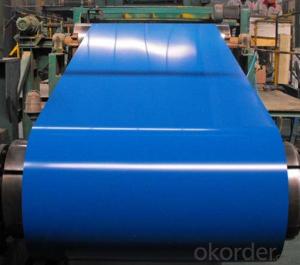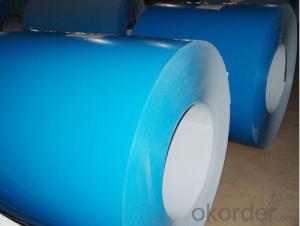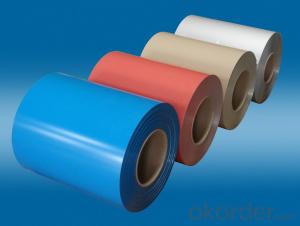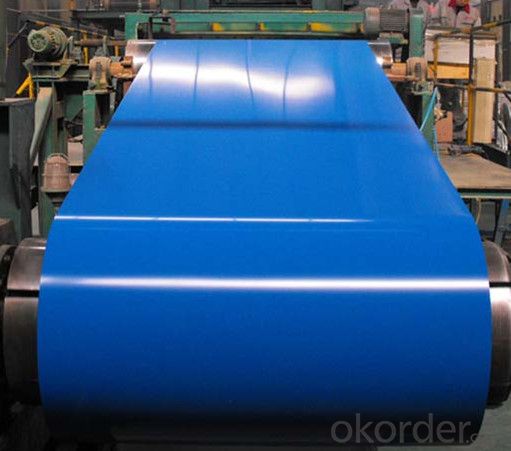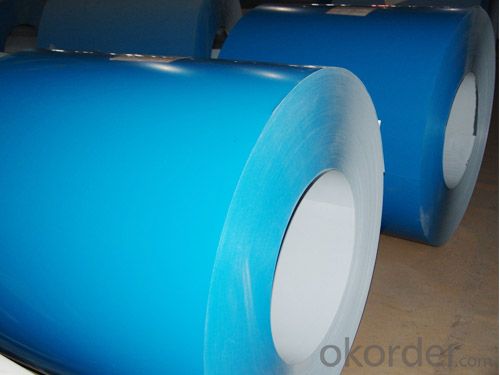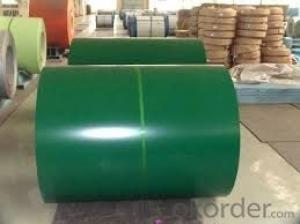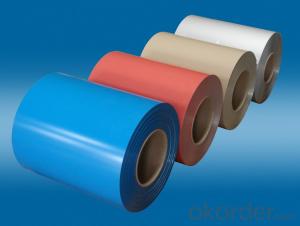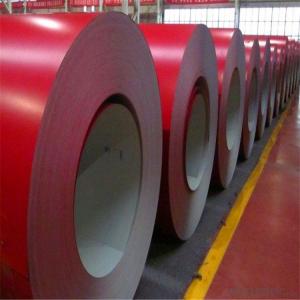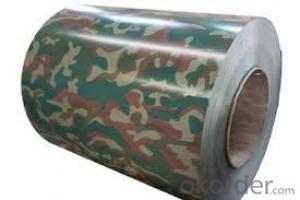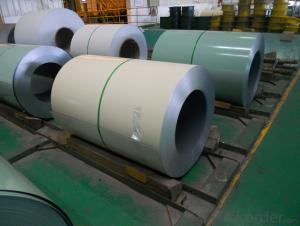printed steel coil / PPGI steel coil HDP
- Loading Port:
- China Main Port
- Payment Terms:
- TT OR LC
- Min Order Qty:
- -
- Supply Capability:
- -
OKorder Service Pledge
OKorder Financial Service
You Might Also Like
Printed steel coil specification
Product:ASTM prepainted steel coil
Base plate:Cold rolled steel sheet, hot dipped zinc coated steel sheet, hot dipped A-Z coated steel sheet
Capacity:10000MT/month
Thickness:0.16-1.0mm (tolerance+/-0.02mm)
width:600-1250mm(tolerance+/-2mm)
Zinc coating:40-150g/m2
Type of coating structure:2/1 coating
Paint thickness:top25+/-5um;back5-9um
Coil weight:4-6MT
Coil ID:508MM/610MM
Base sheet:cold rolled steel sheet,hot dip zinc coated steel sheet(zero,small,general,big spangle),hot dipped zinc coated steel sheet
Surface paint:EP,PE,HDP,SMP,PVDF
Color series:RAL number or sample color
Surface type:printed,embossed,corrugated
Trade terms:Within 10-15 days after the deposit or L/C at sight
Payments:L/C orT/T
Printed steel coil Application
CONSTRUCTION | Outside | Workshop, agricultural warehouse, residential precast unit, corrugated roof, roller shutter door, rainwater drainage pipe, retailer booth |
Inside | Door, doorcase, light steel roof structure, folding screen, elevator, stairway, vent gutter | |
ELECTRICAL APPLICANCE | Refrigerator, washer, switch cabinet, instrument cabinet, air conditioning, micro-wave oven, bread maker | |
FURNITURE | Central heating slice, lampshade, chifforobe, desk, bed, locker, bookshelf | |
CARRYING TRADE | Exterior decoration of auto and train, clapboard, container, isolation lairage, isolation board | |
OTHERS | Writing panel, garbage can, billboard, timekeeper, typewriter, instrument panel, weight | |
- Q: Hello,I have been thinking about buying a Tungsten Carbide Diamond wedding band for my husband but one of my family members keep telling me that Tungsten Carbide is merely steel and hence, a low quality metal, therefore, I shouldn't buy it. I don't really know much about it. Please if anyone can tell me more about this metal? Thanks.
- Edmond, a laser doesn't scratch anything, it melts. We're talking physical properties, not plasma properties. At NORMAL temperatures of 70-90 degrees F. If you don't understand the question, quit answering. Id imagine tungsten carbide can scratch itself. Much like an ape. :) - The Gremlin Guy -
- Q: What are the different types of steel coil edge trimming methods?
- There are several different types of steel coil edge trimming methods, including shearing, slitting, and laser cutting.
- Q: What we have to keep in mind before buying a steel building?
- Before okorder /... Hope this will prove helpful to you.
- Q: I want to save water $$, so I want to use frozen steel to cool my coke. possible or no?
- Wouldn't it be easier to stick your coke in the freezer?
- Q: How do steel coils contribute to durability and longevity in products?
- Steel coils contribute to durability and longevity in products mainly due to their strength, stability, and corrosion resistance. Firstly, steel is renowned for its exceptional strength, making it an ideal material for various applications where durability is crucial. Steel coils, which are essentially tightly wound rolls of steel, provide added strength and structural integrity to products. The stability offered by steel coils is another key factor in enhancing the durability of products. The tightly wound structure of the coils ensures they maintain their shape and resist deformation under heavy loads or extreme conditions. This stability is particularly important in industries such as construction and automotive, where products need to withstand rigorous usage over extended periods. Moreover, steel coils possess exceptional corrosion resistance properties, primarily due to the presence of protective coatings. These coatings, such as zinc or other metallic alloys, act as a barrier against moisture and environmental elements that can cause rust and degradation. By preventing corrosion, steel coils help prolong the lifespan of products, making them more durable and reliable. Additionally, steel coils can be customized to meet specific requirements, such as different thicknesses, widths, or surface finishes. This versatility allows manufacturers to tailor the steel coils to their desired application, ensuring optimal performance and longevity in their products. In summary, steel coils contribute to durability and longevity in products through their strength, stability, corrosion resistance, and customization capabilities. By incorporating steel coils into various industries and applications, manufacturers can ensure their products withstand the test of time, ultimately benefiting consumers with longer-lasting and more reliable products.
- Q: How are steel coils inspected for surface cleanliness using cleanliness tests?
- Steel coils are inspected for surface cleanliness using cleanliness tests to ensure that they meet the required quality standards. These tests involve various methods to assess the presence of contaminants, such as dirt, oil, grease, rust, or scale, on the surface of the steel coils. One commonly used cleanliness test is the visual inspection, where trained inspectors visually examine the surface of the coils for any visible contaminants. They look for any signs of staining, discoloration, or foreign substances that may affect the quality of the steel. Another cleanliness test is the wipe test, where a clean cloth or wipe is used to wipe the surface of the steel coil. This cloth is then analyzed for the presence of contaminants using techniques like gravimetric analysis or solvent extraction. The amount of contaminants collected on the cloth can be measured, providing an indication of the cleanliness of the steel surface. Surface roughness tests are also performed to assess cleanliness. A roughness gauge is used to measure the roughness of the steel surface, which can indirectly indicate the presence of contaminants. If the surface roughness measurements are higher than the specified limits, it suggests the presence of contaminants affecting the cleanliness of the steel. In addition to these tests, cleanliness tests may also involve techniques like wetting tension measurement, water break test, or contact angle measurements. These tests evaluate the surface energy and wetting properties of the steel, which can be affected by the presence of contaminants. By conducting cleanliness tests, steel coils can be thoroughly inspected for surface cleanliness. These tests help in identifying any potential contaminants that may compromise the quality and performance of the steel. By ensuring the surface cleanliness of steel coils, manufacturers can provide high-quality products that meet the stringent requirements of various industries.
- Q: hey... i don't need to change my strings, but i found a set of Bronze acoustic guitar strings by pure tone... i have a few questions on them:can i put them on a steel string guitar? i know i can't put nylon strings on... but i don't see why i can't put bronzethey are light gauze... i have no idea what my current gauze is, but i play in Dropped D tuning... so would the E/D string (6th) be too loose? finally, can you get strings designed to be played in Drop D?any help is apprechiated :D
- I don't see why not. Put them on and try it out.
- Q: How are steel coils used in the manufacturing of food processing equipment?
- Steel coils are used in the manufacturing of food processing equipment to create sturdy and durable structures. These coils are often formed into various shapes and sizes to serve as the framework for machines such as mixers, grinders, ovens, and conveyors. The strength and resilience of steel make it an ideal material for withstanding the demanding conditions of food processing, ensuring the safety and efficiency of the equipment.
- Q: I know there is soft steel and sturdier steel they use in products. The sturdier often used for equipment that requires more durability when in operation.
- harder steel has a higher carbon and chromium content
- Q: Which of the two are better for exhaust manifolds, im guessing the stainless steel right?
- For strength, cast iron (that's why OEM exhaust manifolds are made out of it). For performance, stainless steel. For one, stainless steel headers are lighter than cast iron ones. Then they come in multiple arrangements, (4-2-1 or 4-1 for 4 cylinder motors). The down fall is strength. Hit a pot hole with the collector of a stainless steel header. It's going to have a nice dent in it.
Send your message to us
printed steel coil / PPGI steel coil HDP
- Loading Port:
- China Main Port
- Payment Terms:
- TT OR LC
- Min Order Qty:
- -
- Supply Capability:
- -
OKorder Service Pledge
OKorder Financial Service
Similar products
Hot products
Hot Searches
Related keywords
